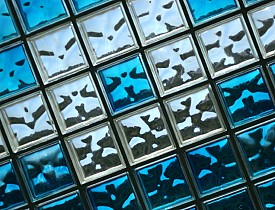Translucent, but Not Transparent, Glass Options
 From front entryways to shower doors, there are many reasons you might need glass that offers some privacy while still letting in plenty of light. Thankfully, there are as many options as there are reasons for glass that is translucent (lets in light) but not transparent (clear, see-through). Here is a brief breakdown of a few types of translucent glass.
From front entryways to shower doors, there are many reasons you might need glass that offers some privacy while still letting in plenty of light. Thankfully, there are as many options as there are reasons for glass that is translucent (lets in light) but not transparent (clear, see-through). Here is a brief breakdown of a few types of translucent glass.
Frosted glass: Glass can be uniformly sandblasted to create a solid frosted look. It is commonly used in everything from shower doors to stemware. For more decorative frosting patterns, glass is typically etched with acid. Some glass companies offer frosted glass as an option for nearly any window or other application. Many types of glass are available with a frosted finish for a premium price.
Glass film: A cheaper, temporary DIY alternative is glass film. A wide variety of films can easily be stuck to windows for a patterned or uniform frosted appearance. Canned sprays also are available for creating a temporary imitation frosted glass appearance.
Leaded glass: A bit of a misnomer, leaded glass may be coppered, zinced or brassed glass. Any of these soft metals can be formed into "cames," thin edges between pieces of glass. The most famous and ornate examples are stained glass windows in cathedrals and important public buildings. The small pieces and the nature of the glass make leaded glass hard to see through. It may be an artistic feature in a living room with direct sunlight that's refracted through the glass. Paints and patterns are available to create imitation leaded glass.
Glass block: As the name suggests, glass block (AKA "glass brick") is an architectural glass, often used in garages or other industrial applications. Glass blocks are like thick, oversized glass tiles. They are sometimes used in homes for entryways or bathroom windows. They also may serve as a decorative element, such a half-wall in a bathroom.
Smart glass: A handful of companies are making advanced privacy glass that can alternate between translucent and transparent. "Smart" glass has an embedded layer of liquid crystal molecules which obscure the glass but still let light pass. However, at the flick of a switch, the liquid crystals align to allow a clear view. This glass is used in some hospitals to help create privacy for patients when they wish. In homes, smart glass front windows provide privacy as needed, while admitting natural daylight.
A wide variety of translucent, but not transparent, glass is available for providing privacy without sacrificing natural light. Find an experienced professional to install translucent glass in your home.
Updated January 1, 2018.
Looking for a Pro? Call us (866) 441-6648

Average Costs
Related Experiences

Emergency Garage Door Replacement

Do Your Homework Before You Have A New Water Heater Installed



